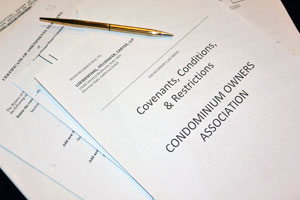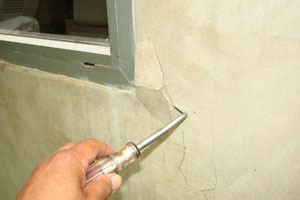LHC Newsletter Vol. 10, No. 2
NOISY NEIGHBORS: HOW DOES THE ASSOCIATION TURN THE SOUND DOWN? (And, does it have to in all cases?)
By: Robert D. Hillshafer, Esq.
Barbara A. Higgins, Esq.
Most of us love dogs, but not when we can’t see them. In some instances, we can only hear them. What is an Association to do when a dog barks loudly, some for prolonged periods, or acts like a watch dog protecting his or her domain? Should the Association act, and if so, when and what should it do?
While living in close quarters such as a condominium development, it is not unusual to hear the sound of barking dogs. Obviously, reasonable tolerance is key especially for owners and tenants who live in communities with more dogs than others[1]. Association members need to expect some degree of barking. It is when the barking becomes intolerable because it is prolonged, or too frequent, or is at an inappropriate time of day or night, that it becomes an issue. Even dog lovers will become annoyed if a dog is left alone in a unit for too long, and starts barking due to hunger, separation anxiety, outside noises, or the need to go outside.
Associations and their members are subject to and governed by recorded Declarations (“CC&Rs”) and Operating Rules which are recognized to be legally enforceable by both an owner or by the Association. There is inevitably a provision in the CC&Rs or Rules about the right to, or preservation of, “quiet enjoyment”. This does not translate into homeowners always having a right to a “noise-free” environment[2]. The occasional barking dog, crying child, or nearby party is inevitable and not actionable. But, loud music is not always “music to the ears”. It can amount to interference with quiet enjoyment. Quiet enjoyment is the right of a property owner or tenant to enjoy his/her property in peace without unreasonable interference. It is the timing of, number of residents impacted, intensity and duration which determines whether the Association needs to act to abate the noise. Disruption of quiet enjoyment when persistent, frequent, and/or “too loud for too long”, can certainly rise to the level of “nuisance”.
Under Civil Code Section 3479, “Nuisance” is defined in primary part as “anything which is injurious to health, including, but not limited to, the illegal sale of controlled substances, or is indecent or offensive to the senses, or an obstruction to the free use of property, so as to interfere with the comfortable enjoyment of life …” (Emphasis added.) This is a rather broad, subjective definition to which logic must be applied. Many CC&Rs contain a provision stating that any violation of the CC&Rs constitutes a nuisance that is subject to legal action by the Association or any member. Some CC&Rs provide that the Board has the sole discretion to determine the existence of a nuisance.
If a neighbor makes it a habit to mow his or her lawn on Saturday afternoons when others are trying to read or nap, this must be weighed against the benefit and logic of the neighbor doing the “right thing” by maintaining his yard when he can, especially when required to work during the week. If the same neighbor insists on mowing his lawn in the middle of the night or before 7:00 a.m. on the weekend when most other homeowners and tenants are sleeping, then he pushes the “nuisance envelope”, and there is far less room for tolerance.
As with any loud or annoying noise, when determining if it is a violation of the CC&Rs or constitutes a nuisance, consideration should be given to the time of day, duration, and frequency. Certain types of behavior will be deemed a nuisance almost automatically such as a dog who also chases or bites people, or a dog or person who habitually creates disturbances and loud noises for prolonged periods, especially during the night.
The best, initial approach for Associations is to encourage the affected parties to attempt to work out a reasonable solution between themselves, with possible suggestions from the Association if useful or necessary. For example, if a dog barks persistently during a particular time of day or night, the affected neighbor could keep a log or notes about the times, dates, and length of the barking, and any known or suspected source which triggers the barking, such as gardeners or being left alone too many hours without a break. Documentation of such disturbances is very important in the event that informal attempts to abate are unsuccessful and legal process is invoked. In fairness to both, and to curb simmering or divisive hard feelings, the dog owner should be promptly supplied with this information, so the right steps can be taken to stop or control the barking through various means (i.e., the hiring of a dog trainer, a dog walker to help with prolonged owner absences, the use of a bark collar, a soothing sound machine, etc.). Often this is accomplished through a “courtesy notice” from the Association, reminding the owner of his or her obligations under the governing documents to be sensitive to the other residents. If the neighbors feel comfortable with one another, cell phone numbers or email addresses should be exchanged, so that the dog owner can be promptly notified when the barking exceeds “normal” levels, and should be corrected.
If the neighbors are too hostile towards one another, then what happens? In the case of barking dogs, Board members or Animal Control[3] can be called upon to help mediate and intervene. However, Animal Control often has its own large caseload and may not do much except issue citations and collect unpaid licensing fees. This may encourage the parties to work together because they have to. But, if a solution cannot be reached, the affected neighbor could take the dog owner to Court if there are enough witnesses, or there is recorded evidence of the barking to support his or her nuisance case.
Does the Association need to get involved more directly? That depends on the CC&Rs as written and the level and frequency of the noise and how many residents are impacted by it. However, since Associations have a duty to enforce restrictions, it follows that they have a duty to investigate complaints by residents about nuisance and rules violations and take some measure of action to address violations. The CC&Rs set forth the available remedies and processes which are available and applicable.
If there are specific requirements stated in the governing documents which regulate certain types of noise, such as decibel levels of music or the sound impact of upstairs neighbors walking on non-carpeted floors, then the Association should act reasonably in enforcing them. But this does not necessarily mean that the Association must go to the logical extreme in every instance, as that would create a financial burden that the Association could not support. Again, it does not hurt to start with informal dispute resolution meet and confers and similar logical solutions to correct the problem in a rational, non-escalated manner. This could take place by a Board Member designated to meet with the other parties visiting the units, or could be accomplished at a disciplinary hearing where the Board can consider imposing a fine or other discipline. Alternative dispute resolution (“ADR”) is generally required before either the Association or an owner may file an enforcement action in court seeking injunctive relief. The ADR process is designed to preempt litigation through getting the parties to engage with a third party neutral before incurring substantial attorneys’ fees and costs.
In condominium complexes with stacked units, there are often sound transmission issues between upper and lower units. These can range from heavy or frequent walking sounds to children running and shrieking, to blaring TV’s and music; even very early wake-up showers and doors or drawers shutting in the wee hours of the morning or night. The most common of these complaints relates to hard surface flooring (such as wood, tile, and stone) which can be perceived to amplify noises to those below. Some CC&Rs or other governing documents do not prohibit hard surface flooring in the units above the ground floor, and especially now that hard wood engineered flooring is popular, this can become a real issue. However, most cities have ordinances which require that noise levels conform to certain sound transmission levels or decibel requirements so as not to constitute a nuisance. If they do not meet a specified threshold, then sound reducing materials may be required to avoid legal problems, such as extra padding or underlayment.
Some CC&Rs spell out the noise transmission levels to which the homeowner members must adhere. This is a good idea for any Association as long as the right sound proofing professionals and/or legal counsel are consulted to determine what levels will actually accomplish the best, reasonable results. (Building codes typically require that floors have enough airborne sound insulation to meet an STC of 45 (field-tested) and an IIC of 45 (field tested) for impact noise between units. These standards are rather modest in application and for local building codes may require higher standards.) If not in the CC&Rs, then Associations must rely on city ordinances to provide governing noise levels and prohibitions, to the extent they are specific enough to cover issues common to Association communities. However, to really analyze the situation requires acoustical testing of the unit before the installation and after the installation to determine if the new materials allow greater sound transmission than the previous flooring. There are multiple components to sound transmission, including the construction techniques and materials used in constructing the floor/ceiling assembly. The goal is to not allow modifications that “increase” the sound transmission levels between units.
If a purported violation is reported that a hard surface flooring was installed which does not comply with the Association’s governing documents or exacerbates sound transmission issues, a Board member should visit the complaining owner’s unit to attempt to determine whether there is an objective problem. If there appears to be a possible violation, objective testing can be done to determine the acoustical levels, and this testing should (ideally) be paid for by the complaining owner and submitted with their written complaint/violation. However, rarely will owners agree to pay for such testing except when a specific condition of architectural approval. But the Board needs this information to make a decision and may then seek reimbursement from the owner if appropriate. A clear set of guidelines and expectations in this context can make all the difference.
If the CC&Rs do not have an objective standard, then the Board can also subjectively determine whether a noise nuisance exists whether it relates to upstairs flooring or something else such as laundry machine or television noise. From the complaining unit, the Board member (or a representative) can listen to the noise and vibration. If the Board makes a good faith determination that it does not rise to the level of a nuisance, no further action may be required by the Board. A “reasonable” hearing person standard should be used for assessment, not someone with impaired hearing or hypersensitivity to noise. If the complaining owner disagrees with the finding, he or she still has the right to initiate legal action against the alleged noisy neighbor. Unfortunately, the Association often is also named in such suits because the aggrieved owner believes the Association did not make the right decision or “do enough” to help solve the problem.
If the Association finds that the noise is excessive, it can demand that the owner abate the nuisance through a variety of means. That might require the installation of noise attenuating padding and materials, added insulation, felt cushions under furniture legs, or even the removal of the noise-producing flooring or source of the noise. If the homeowner does not comply or if fines do not curb the nuisance, the Board can initiate legal action against the upstairs homeowner seeking the removal of the non-compliant flooring, or installation of compliant flooring materials. These enforcement actions are very costly and should not be approached lightly and without objective evidence of a violation of the governing documents.
In general, a homeowners’ association, through its Board of Directors, has a duty to enforce its governing documents. Nahrstedt v. Lakeside Village Condominium Assoc. (1994) 8 Cal.4th 361, 373-374, 380-383. Associations can enforce restrictions through fines, suspension of privileges and legal action for injunctive relief.
Although a homeowners’ association does have some discretion to decide whether, and in what manner, to enforce the governing documents, this discretion must be exercised consistent with its fiduciary duties and the CC&Rs. Ekstrom v. Marquesa at Monarch Beach Homeowners Assn. (2008) 168 Cal.App.4th 1111, 1121-25; Lamden v. La Jolla Shores Condominium Homeowners Assn (1999) 21 Cal.4th 249, 268. The decision to litigate to enforce governing documents is also discretionary. Boards can balance and weigh the cost of litigation, the gravity of the violation, and the likely outcome of the litigation, in order to make a good faith determination.
Because a nuisance is often subjective, the Association should carefully craft and adopt guidelines addressing common problems, such as hardwood floors, excessive barking, loud music/entertainment, etc., by imposing restrictions which will in essence, “keep the sound down”. Obtaining input from legal counsel and construction professionals relative to objective testing requirements and standards is critical. The “volume” will only be turned up throughout the Association community, without consistent remedial or preventative action being taken in a fair and reasonable manner.
[1] Governing documents adopted or amended from January 1, 2001, onward may not prohibit an owner from keeping at least one domesticated bird, cat, dog, or aquatic animal in an aquarium, but the Association may enact reasonable rules and regulations about pets. See Civil Code Section 4715.
[2] “[E]very annoyance or disturbance of a landowner … by a neighbor does not constitute a nuisance. The question is not whether the plaintiffs have been annoyed or disturbed … but whether there has been an injury to their legal rights. People who live in organized communities must of necessity suffer some inconvenience and annoyance from their neighbors and must submit to annoyances consequent upon the reasonable use of property by others.” (Emphasis added.) Schild v. Rubin (1991) 232 Cal.App.3d 755, 764.
[3] Every county, city and town has its own local laws, called “municipal codes.” The code sections that apply specifically to animal care and ownership come under the heading “animal control.” When local officials believe a resident has violated a code section, the resident is issued a citation (aka “a ticket”), and a hearing is held under certain circumstances, if the dog owner disputes it, to determine if a violation occurred. An animal control hearing is usually (with few exceptions) administrative, not a formal court proceeding, and determines if an animal owner* or keeper should pay a fine or be subject to a condition for violating a local law about animals. As a matter of practice, animal control officers focus more of their time on dangerous dogs and strays than barking dogs. It would be a rare case for Animal Control to act in removing a dog from the home because of barking. There would have to be many witnesses and complaints before such behavior would even become a priority. That is why such cases are best resolved, first, by the neighbors involved, and second, with the assistance of the Association.


